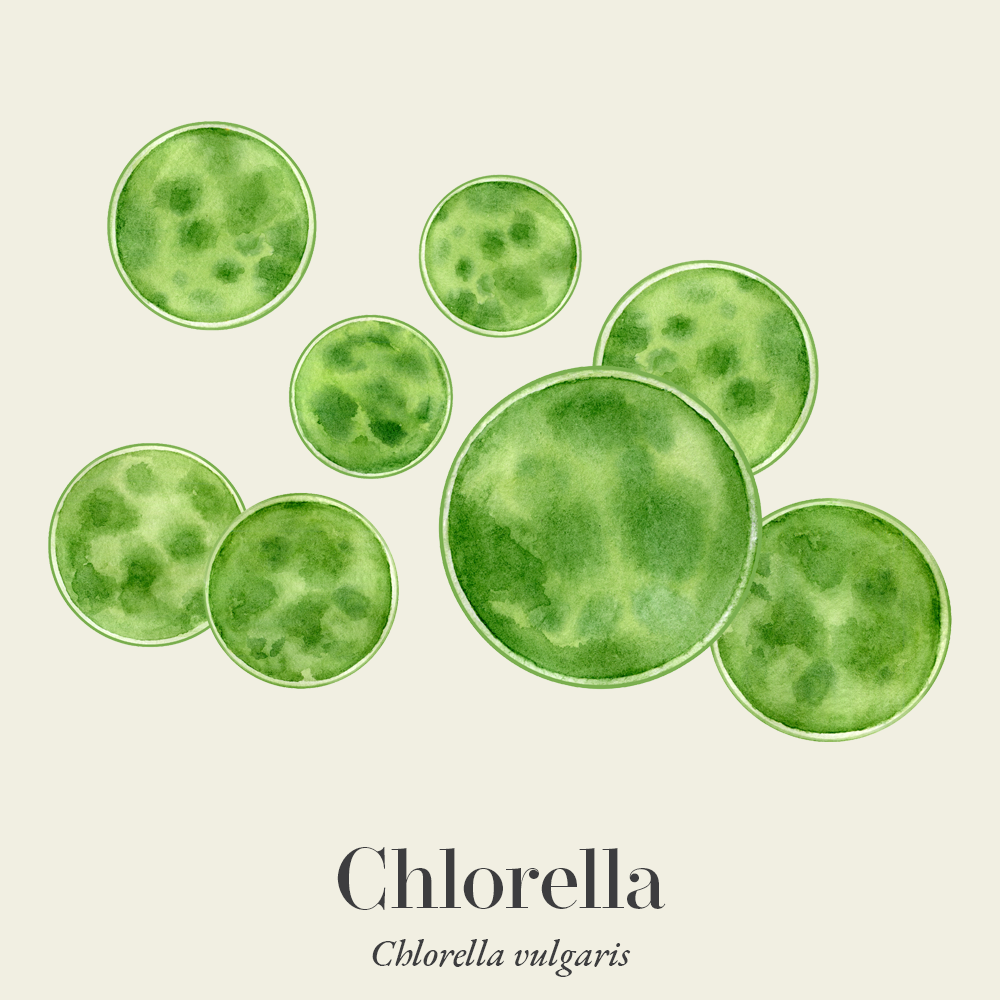-
How does it feel?
Chlorella is one of the earliest photosynthesising microscopic freshwater plants evolving over 2 billion years ago. It is a single-cell green algae. Chlorella contains the green pigment chlorophyll, giving it a distinct green colour and will multiply rapidly through the process of photosynthesis.
-
What can I use it for?
 Chlorella Growth Factor constitutes 2.5% of chlorella’s total components and is a complex of nucleic acids (DNA and RNA) which give it the ability to repair cellular, nerve and muscular tissue in the body. It increases macrophage, T-cell and B-cell activity through stimulation of the immune system and also increases interferon production. Chlorella growth factor also increases the numbers of white blood cells, red blood cells and platelets.
Chlorella Growth Factor constitutes 2.5% of chlorella’s total components and is a complex of nucleic acids (DNA and RNA) which give it the ability to repair cellular, nerve and muscular tissue in the body. It increases macrophage, T-cell and B-cell activity through stimulation of the immune system and also increases interferon production. Chlorella growth factor also increases the numbers of white blood cells, red blood cells and platelets.Chlorella is well known as an effective heavy metal and pollutant detoxifier, proven to remove cadmium, lead, uranium, mercury and dioxins.
Chlorella contains Chlorophyll and has the highest known concentration of any plant at 3%. Chlorophyll has a plethora of fantastic properties:
- Antioxidant and detoxifying actions neutralise oxidative stressors reducing damage from environmental pollutants whilst also clearing deep seated congestion and stagnation
- Rejuvenation by building and repairing red blood cells
- Alkalising the blood so that it can maintain a healthy PH of 7.2
- High levels of minerals such as magnesium and zinc which relax the nervous system and support immunity
- Oxygenation of the blood
- Encouraging a healthy inflammation response specifically within the digestive system and the liver
-
Into the heart of chlorella
Chlorella is a little gem packed with all your daily essentials. Chlorella has an energising nutritional profile and is packed with protein, Vitamin D and B vitamins. Chlorella Growth Factor provides superb protection and support for the immune system and encourages cell repair and renewal throughout the body. Chlorophyll is one of Chlorella’s main components and gives superb antioxidant protection whilst also encouraging effective detoxification of heavy metals and pollutants, reducing the internal inflammation that these toxins can influence.
As the number of environmental pollutants we are exposed to increases through atmospheric pollutants and our diet, effective detoxification becomes essential to maintaining a healthy internal environment. If left to accumulate, the body can become burdened with toxic overload and vital processes such as cell growth, renewal and repair become hindered.Effective detoxification and cleansing of heavy metals and pollutants will rejuvenate the whole body. Chlorella is unique in that it will detoxify but also protect against further oxidative damage. Chlorella Growth Factor will keep the immune system strong and cellular processes will be kept at optimum functioning.
-
Traditional actions
Herbal actions describe therapeutic changes that occur in the body in response to taking a herb. These actions are used to express how a herb physiologically influences cells, tissues, organs or systems. Clinical observations are traditionally what have defined these actions: an increase in urine output, diuretic; improved wound healing, vulnerary; or a reduction in fever, antipyretic. These descriptors too have become a means to group herbs by their effects on the body — herbs with a nervine action have become the nervines, herbs with a bitter action are the bitters. Recognising herbs as members of these groups provides a preliminary familiarity with their mechanisms from which to then develop an understanding of their affinities and nuance and discern their clinical significance.
-
Traditional energetic actions
Herbal energetics are the descriptions Herbalists have given to plants, mushrooms, lichens, foods, and some minerals based on the direct experience of how they taste, feel, and work in the body. All traditional health systems use these principles to explain how the environment we live in and absorb, impacts our health. Find out more about traditional energetic actions in our article “An introduction to herbal energetics“.
-
Did you know?
Chlorella was not discovered until the end of the 19th century when it was named after ‘chlor’ meaning ‘green’ in Greek and ‘ella’ meaning ‘a small thing’ in Latin. Chlorella also has a tough outer wall that has to be ‘cracked’ or ‘rolled’ to release its potent nutritional essence.
Additional information
-
Safety
No drug-herb interactions are known.
-
Dosage
500mg-3000mg per day for maintenance and up to 9000mg per day for short periods of intense detoxification.






























 Chlorella Growth Factor constitutes 2.5% of chlorella’s total components and is a complex of nucleic acids (DNA and RNA) which give it the ability to repair cellular, nerve and muscular tissue in the body. It increases macrophage, T-cell and B-cell activity through stimulation of the immune system and also increases interferon production. Chlorella growth factor also increases the numbers of white blood cells, red blood cells and platelets.
Chlorella Growth Factor constitutes 2.5% of chlorella’s total components and is a complex of nucleic acids (DNA and RNA) which give it the ability to repair cellular, nerve and muscular tissue in the body. It increases macrophage, T-cell and B-cell activity through stimulation of the immune system and also increases interferon production. Chlorella growth factor also increases the numbers of white blood cells, red blood cells and platelets.





